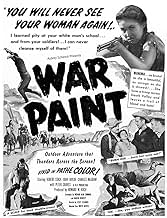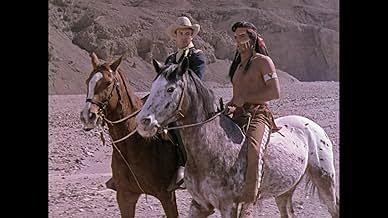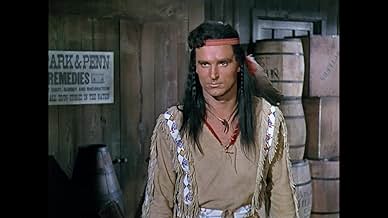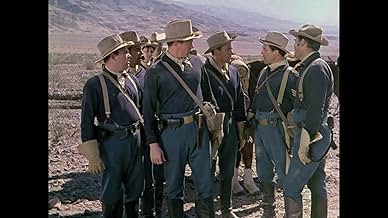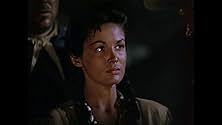Agrega una trama en tu idiomaAn Indian and his beautiful sister attempt to destroy a cavalry patrol trying to deliver a peace treaty to their chief.An Indian and his beautiful sister attempt to destroy a cavalry patrol trying to deliver a peace treaty to their chief.An Indian and his beautiful sister attempt to destroy a cavalry patrol trying to deliver a peace treaty to their chief.
- Dirección
- Guionistas
- Elenco
Robert J. Wilke
- Trooper Grady
- (as Robert Wilke)
Richard H. Cutting
- Commissioner Kirby
- (as Richard Cutting)
Anthony Jochim
- Trading Post Proprietor
- (sin créditos)
Opiniones destacadas
"War Paint" (1953) starring Robert Stack is a good "mission across the desert" movie with good actors, an OK script, and portrays US Army deserters who murder loyal Army soldiers and try to murder their commanding officer, and almost succeed.
Very few movies portray this important military discipline problem which has happened often in US and other Army military history.
US Army officers are issued sidearms (handguns) to defend themselves against enlisted men they command who may decide to disobey orders and murder the commander who gave them orders they disobey.
During the War In Vietnam, the phenomenon of enlisted men murdering officers who commanded them was publicized and often called "fragging." Enlisted men who attack and try to murder officers, and sometimes succeed, is not new to military experience. Leading a military unit is dangerous for many reasons, not only because of enemy fire, but due to "friendly fire" from soldiers part of one's military group, which "friendly fire" is, sadly and tragically, sometimes intentional.
Murdered officers killed by their own men is not new in military history.
This "War Paint" (1953) movie set in desert country about a small military unit led by a single junior (low level) officer (a Lieutenant) played by Robert Stack shows enlisted men, about a dozen of them, made desperate by harsh no-water desert conditions, and greedy due to a gold mine they come across on their way to delivering a peace treaty to an Indian tribal chief (the mission the military group has in the "old West" of post-Civil War 19th century times in the far west desert country. (This movie was shot entirely in California's "Death Valley," located near the Nevada/ California state border, famous for it's moonscape appearance where almost nothing, plant or animal, can live, or does.) The movie story is very simple, and not a little eerie.
It was made the same year Robert Stack starred in the first 3-D movie titled "Bwana Devil," set in Africa.....another Robert Stack adventure movie.
"War Paint" is a good movie for several reasons, including it's unusual and forthright treatment of bad soldiers doing damage to good soldiers, all in the same Army and supposed to be on the "same team." A single female character is included in the cast, and she is supposed to be an Indian maiden, the daughter of the Indian tribal chief the military group seeks to present with a US Govt. peace treaty.
The girl is beautiful, dressed in a form fitting doe-skin dress, has a perfect complexion, lovely thick dark braided hair, every hair neatly in place, a very pretty face, and a great, curvy female figure, including chorus girl legs shown off when she rides horses or wrestles around on the ground when attacked by soldiers or attacking the soldiers on her own.
She is not a typical movie Indian girl...not submissive, not inarticulate, not demure. She's smart as hell in every way, and shows off her good mental qualities (which match her dazzling appearance) without apology or restraint.
Her physical beauty is a welcome visual relief for movie viewers who must watch the movie story set in the dull and ugly moonscape desert environment which oppresses the struggling soldiers for obvious reasons.
The Indian maiden does not join the military group until the movie is 2/3rds over, and then she is their hostile and unpleasant prisoner, outspokenly "anti-White man!" But we see her (the audience does) well before the actor soldiers do, and we see her comely features and great legs.
She helps her brother, who opposes the US Govt. treaty his father, the Indian tribal chief wants and supports. The brother murders American soldiers, is taken prisoner by the military group, escapes, attacks the group, and finally is killed, all while the younger adult female sister assists her brother and stays out of sight of the military group....until the last 1/3 of the movie when she shoots a straggling soldier during a rifle battle she initiates, and is caught, taken prisoner, and retained as a hostage to present to the Indian tribal chief.
Predictably, she befriends handsome Robert Stack, and at the end of the movie, only the two of them (Stack and the girl) remain....all other soldiers part of the "mission across the desert" have died.....most due to being killed by fellow soldiers.
The whole movie is unusual and thought provoking, worth seeing.
-----------------
Written by Tex Allen, SAG-AFTRA movie actor. Visit WWW.IMDb.Me/TexAllen for more information about Tex Allen.
Tex Allen's email address is TexAllen@Rocketmail.Com.
See Tex Allen Movie Credits, Biography, and 2012 photos at WWW.IMDb.Me/TexAllen. See other Tex Allen written movie reviews....almost 100 titles.... at: "http://imdb.com/user/ur15279309/comments" (paste this address into your URL Browser)
Very few movies portray this important military discipline problem which has happened often in US and other Army military history.
US Army officers are issued sidearms (handguns) to defend themselves against enlisted men they command who may decide to disobey orders and murder the commander who gave them orders they disobey.
During the War In Vietnam, the phenomenon of enlisted men murdering officers who commanded them was publicized and often called "fragging." Enlisted men who attack and try to murder officers, and sometimes succeed, is not new to military experience. Leading a military unit is dangerous for many reasons, not only because of enemy fire, but due to "friendly fire" from soldiers part of one's military group, which "friendly fire" is, sadly and tragically, sometimes intentional.
Murdered officers killed by their own men is not new in military history.
This "War Paint" (1953) movie set in desert country about a small military unit led by a single junior (low level) officer (a Lieutenant) played by Robert Stack shows enlisted men, about a dozen of them, made desperate by harsh no-water desert conditions, and greedy due to a gold mine they come across on their way to delivering a peace treaty to an Indian tribal chief (the mission the military group has in the "old West" of post-Civil War 19th century times in the far west desert country. (This movie was shot entirely in California's "Death Valley," located near the Nevada/ California state border, famous for it's moonscape appearance where almost nothing, plant or animal, can live, or does.) The movie story is very simple, and not a little eerie.
It was made the same year Robert Stack starred in the first 3-D movie titled "Bwana Devil," set in Africa.....another Robert Stack adventure movie.
"War Paint" is a good movie for several reasons, including it's unusual and forthright treatment of bad soldiers doing damage to good soldiers, all in the same Army and supposed to be on the "same team." A single female character is included in the cast, and she is supposed to be an Indian maiden, the daughter of the Indian tribal chief the military group seeks to present with a US Govt. peace treaty.
The girl is beautiful, dressed in a form fitting doe-skin dress, has a perfect complexion, lovely thick dark braided hair, every hair neatly in place, a very pretty face, and a great, curvy female figure, including chorus girl legs shown off when she rides horses or wrestles around on the ground when attacked by soldiers or attacking the soldiers on her own.
She is not a typical movie Indian girl...not submissive, not inarticulate, not demure. She's smart as hell in every way, and shows off her good mental qualities (which match her dazzling appearance) without apology or restraint.
Her physical beauty is a welcome visual relief for movie viewers who must watch the movie story set in the dull and ugly moonscape desert environment which oppresses the struggling soldiers for obvious reasons.
The Indian maiden does not join the military group until the movie is 2/3rds over, and then she is their hostile and unpleasant prisoner, outspokenly "anti-White man!" But we see her (the audience does) well before the actor soldiers do, and we see her comely features and great legs.
She helps her brother, who opposes the US Govt. treaty his father, the Indian tribal chief wants and supports. The brother murders American soldiers, is taken prisoner by the military group, escapes, attacks the group, and finally is killed, all while the younger adult female sister assists her brother and stays out of sight of the military group....until the last 1/3 of the movie when she shoots a straggling soldier during a rifle battle she initiates, and is caught, taken prisoner, and retained as a hostage to present to the Indian tribal chief.
Predictably, she befriends handsome Robert Stack, and at the end of the movie, only the two of them (Stack and the girl) remain....all other soldiers part of the "mission across the desert" have died.....most due to being killed by fellow soldiers.
The whole movie is unusual and thought provoking, worth seeing.
-----------------
Written by Tex Allen, SAG-AFTRA movie actor. Visit WWW.IMDb.Me/TexAllen for more information about Tex Allen.
Tex Allen's email address is TexAllen@Rocketmail.Com.
See Tex Allen Movie Credits, Biography, and 2012 photos at WWW.IMDb.Me/TexAllen. See other Tex Allen written movie reviews....almost 100 titles.... at: "http://imdb.com/user/ur15279309/comments" (paste this address into your URL Browser)
You can almost hear the grunting and straining as director Lesley Selander labors mightily to arise from the quicksand of the Saturday afternoon cowboy matinee that has been his happy place to the more rarified air of the 1950s psychological western. Ultimately, of course, Selander loses the battle and slips back into standard hero/villain, shoot em up land but it was a noble attempt and should be recognized as such. Of course, Selander isn't helped in his struggle by having around his neck the millstone of a supremely dull leading man, Robert Stack, who seemed to do decent work only when Sirk was around to direct him. And the screenplay, with its yawner of a mutiny sub plot and a most unconvincing, 180 degree switch of character on the part of Joan Taylor, is not exactly Frank Nugent or Marguerite Roberts. So let's give it a generous C plus for the scenes of survival in the desert and good support from such 50s western stalwarts as Charles McGraw, Robert Wilkie and Douglas Kennedy, among others.
War Paint is directed by Lesley Selander and adapted to screenplay by Richard Alan Simmons and Martin Berkeley. It stars Robert Stack, Charles McGraw, Joan Taylor, Peter Graves, Keith Larsen, Robert Wilke and Walter Reed. Music is by Arthur Lange and Emil Newman, and cinematography by Gordon Avil.
A cavalry patrol trying to deliver a peace treaty to Gray Cloud are being destroyed from within by an Indian brother and sister.
Paper of lies!
Filmed out of the superb presence of Death Valley, War Paint is as solid as one of that location's rocks. The title hints at some cheapo "B" Oater, the kind that is all hooray and jingoistic as the cavalry mow down the Indians, but that is not the case. Though an air of familiarity exists, with the core of the story about an army unit literally dying out in the desert, with saboteurs operating within, there's a two sides of the coin pinch in the narrative, with dialogue nicely written with thought and sincerity. Opening with a scalping, drama and suspense is never far away, so as the group implode, with suspicions, thirst and gold fever taking a hold, the viewer is always intrigued as to who will survive and will the treaty ever reach its destination? Plus you may find yourself feeling very thirsty during the viewing...
Very nicely performed and handled with underrated tidy hands by Selander, this is well worth a look by Western fans. 7/10
A cavalry patrol trying to deliver a peace treaty to Gray Cloud are being destroyed from within by an Indian brother and sister.
Paper of lies!
Filmed out of the superb presence of Death Valley, War Paint is as solid as one of that location's rocks. The title hints at some cheapo "B" Oater, the kind that is all hooray and jingoistic as the cavalry mow down the Indians, but that is not the case. Though an air of familiarity exists, with the core of the story about an army unit literally dying out in the desert, with saboteurs operating within, there's a two sides of the coin pinch in the narrative, with dialogue nicely written with thought and sincerity. Opening with a scalping, drama and suspense is never far away, so as the group implode, with suspicions, thirst and gold fever taking a hold, the viewer is always intrigued as to who will survive and will the treaty ever reach its destination? Plus you may find yourself feeling very thirsty during the viewing...
Very nicely performed and handled with underrated tidy hands by Selander, this is well worth a look by Western fans. 7/10
Lesley Selander was a prolific B movie director. That is all I know about him. I do not know that I have watched any of his other flicks, but on the strength of WAR PAINT I would say that I am not losing much.
With a decent cast for a B picture - including Robert Stack, Charles McGraw, Peter Graves, Keith Larsen, Walter Reed and beautiful Joan Taylor as a sqwaw - the acting rates sufficiently high to hold your attention.
The script provides the downside: unrelenting in its penchant for tragedy, we see Larsen as the subversive son of the Indian chief kill soldiers, then his sister Taylor does it, and finally the Cavalary troops kill each other. In between, a soldier who has just become a father drinks poisoned H20 and croaks without seeing his son - the single most tragic and heart-wrenching event in the film.
Stack has a fiancée but by the end of the movie he appears to be more inclined toward going off into the sunset with the Indian chief's daughter, peace looking set to stay.
The length is 89 minutes, pretty standard for B pictures... but it feels a lot longer and heavier, what with all the deaths. 6/10.
With a decent cast for a B picture - including Robert Stack, Charles McGraw, Peter Graves, Keith Larsen, Walter Reed and beautiful Joan Taylor as a sqwaw - the acting rates sufficiently high to hold your attention.
The script provides the downside: unrelenting in its penchant for tragedy, we see Larsen as the subversive son of the Indian chief kill soldiers, then his sister Taylor does it, and finally the Cavalary troops kill each other. In between, a soldier who has just become a father drinks poisoned H20 and croaks without seeing his son - the single most tragic and heart-wrenching event in the film.
Stack has a fiancée but by the end of the movie he appears to be more inclined toward going off into the sunset with the Indian chief's daughter, peace looking set to stay.
The length is 89 minutes, pretty standard for B pictures... but it feels a lot longer and heavier, what with all the deaths. 6/10.
10Kojacque
An unjustly-overlooked masterpiece. The almost-unrecognizably young Robert Stack plays the hardened CO of a company entrusted with delivering a treaty. If the chief for whom it is intended does not receive it within the week, he will declare war. Of course, complications ensue...Many of the characters and plot points seem cliched, but only because the film shows its age. Look past the vestiges of '50s moviemaking--blue-eyed squaws, etc.--for strikingly modern subject matter: divorce and Native American rage at continued injustices in particular. Tremendously taut and exciting, to boot. See this movie!
¿Sabías que…?
- TriviaRobert Stack and Peter Graves would later star in ¿Y dónde está el piloto? (1980), both playing on their own images.
- ErroresAs the rattlesnake moves towards Sgt Clarke (Charles McGraw), the wire used to pull it is clearly visible.
Selecciones populares
Inicia sesión para calificar y agrega a la lista de videos para obtener recomendaciones personalizadas
- How long is War Paint?Con tecnología de Alexa
Detalles
- Fecha de lanzamiento
- País de origen
- Idioma
- También se conoce como
- Im Tal des Verderbens
- Locaciones de filmación
- Death Valley National Park, California, Estados Unidos("War Paint" was photographed in its entirety in beautiful Death Valley National Monument, California)
- Productoras
- Ver más créditos de la compañía en IMDbPro
- Tiempo de ejecución1 hora 29 minutos
- Relación de aspecto
- 1.37 : 1
Contribuir a esta página
Sugiere una edición o agrega el contenido que falta

Principales brechas de datos
By what name was War Paint (1953) officially released in India in English?
Responda

